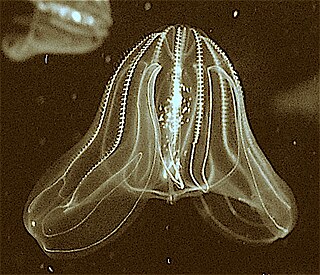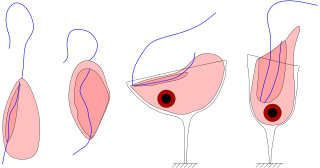
In the fields of molecular biology and genetics, a genome is all the genetic information of an organism. It consists of nucleotide sequences of DNA. The nuclear genome includes protein-coding genes and non-coding genes, other functional regions of the genome such as regulatory sequences, and often a substantial fraction of 'junk' DNA with no evident function. Almost all eukaryotes have mitochondria and a small mitochondrial genome. Algae and plants also contain chloroplasts with a chloroplast genome.

The human genome is a complete set of nucleic acid sequences for humans, encoded as DNA within the 23 chromosome pairs in cell nuclei and in a small DNA molecule found within individual mitochondria. These are usually treated separately as the nuclear genome and the mitochondrial genome. Human genomes include both protein-coding DNA sequences and various types of DNA that does not encode proteins. The latter is a diverse category that includes DNA coding for non-translated RNA, such as that for ribosomal RNA, transfer RNA, ribozymes, small nuclear RNAs, and several types of regulatory RNAs. It also includes promoters and their associated gene-regulatory elements, DNA playing structural and replicatory roles, such as scaffolding regions, telomeres, centromeres, and origins of replication, plus large numbers of transposable elements, inserted viral DNA, non-functional pseudogenes and simple, highly-repetitive sequences. Introns make up a large percentage of non-coding DNA. Some of this non-coding DNA is non-functional junk DNA, such as pseudogenes, but there is no firm consensus on the total amount of junk DNA.

Mitochondrial DNA is the DNA located in mitochondria, cellular organelles within eukaryotic cells that convert chemical energy from food into a form that cells can use, such as adenosine triphosphate (ATP). Mitochondrial DNA is only a small portion of the DNA in a eukaryotic cell; most of the DNA can be found in the cell nucleus and, in plants and algae, also in plastids such as chloroplasts.

In molecular biology and genetics, translation is the process in which ribosomes in the cytoplasm or endoplasmic reticulum synthesize proteins after the process of transcription of DNA to RNA in the cell's nucleus. The entire process is called gene expression.

In molecular biology, a reading frame is a way of dividing the sequence of nucleotides in a nucleic acid molecule into a set of consecutive, non-overlapping triplets. Where these triplets equate to amino acids or stop signals during translation, they are called codons.

Transfer RNA is an adaptor molecule composed of RNA, typically 76 to 90 nucleotides in length, that serves as the physical link between the mRNA and the amino acid sequence of proteins. tRNAs genes from Bacteria are typically shorter than tRNAs from Archaea and eukaryotes. The mature tRNA follows an opposite pattern with tRNAs from Bacteria being usually longer than tRNAs from Archaea, with eukaryotes exhibiting the shortest mature tRNAs. Transfer RNA (tRNA) does this by carrying an amino acid to the protein synthesizing machinery of a cell called the ribosome. Complementation of a 3-nucleotide codon in a messenger RNA (mRNA) by a 3-nucleotide anticodon of the tRNA results in protein synthesis based on the mRNA code. As such, tRNAs are a necessary component of translation, the biological synthesis of new proteins in accordance with the genetic code.

Leuciscus is a genus of fish belonging to the family Cyprinidae. They are inland water fishes commonly called Eurasian daces. The genus is widespread from Europe to Siberia. Species broadly distributed in Europe include the common dace Leuciscus leuciscus and the ide L. idus.

Ulungur Lake is located in Fuhai County, Xinjiang, China. With an area of 1,035 square kilometers, the lake is one of China's ten largest freshwater lakes. Its main tributary is the Ulungur River. It is an endorheic lake, though the Irtysh River flows towards the Arctic Ocean less than 4 km away to the northeast.

Mnemiopsis leidyi, the warty comb jelly or sea walnut, is a species of tentaculate ctenophore. It is native to western Atlantic coastal waters, but has become established as an invasive species in European and western Asian regions. Three species have been named in the genus Mnemiopsis, but they are now believed to be different ecological forms of a single species M. leidyi by most zoologists.

In biology, the word gene can have several different meanings. The Mendelian gene is a basic unit of heredity and the molecular gene is a sequence of nucleotides in DNA that is transcribed to produce a functional RNA. There are two types of molecular genes: protein-coding genes and noncoding genes.
The Sikkim rat is a species of rodent in the family Muridae.

28S ribosomal protein S30, mitochondrial is a protein that in humans is encoded by the MRPS30 gene.

39S ribosomal protein L15, mitochondrial is a protein that in humans is encoded by the MRPL15 gene.

39S ribosomal protein L19, mitochondrial is a protein that in humans is encoded by the MRPL19 gene.

39S ribosomal protein L18, mitochondrial is a protein that in humans is encoded by the MRPL18 gene.

Jakoba is a genus in the taxon Excavata, and currently has a single described species, Jakoba libera described by Patterson in 1990, and named in honour of Dutch botanist Jakoba Ruinen.

Acheilognathus macropterus is a species of cyprinid fish native to China and northern Vietnam. It grows to a length of 27.5 centimetres (10.8 in) SL.
The vertebrate mitochondrial code is the genetic code found in the mitochondria of all vertebrata.

The ovate sole is a species of flatfish in the true sole family, Soleidae native to the Indo-Pacific. Solea ovata has eyes on the right side with small scales on the sides of its body (ovata). The total length of its mitogenome is 16,782 bp with 13 protein-coding genes, 22 tRNA genes, and 2 rRNA genes. The organism, Solea Ovata was found in Guangdong province, China. Solea Ovata are usually found in shallow sand and mud at the bottom of water throughout the coast of Indo-Pacific ocean.

Thymallus baicalensis, also known as the Baikal black grayling, is a Siberian freshwater fish species in the salmon family Salmonidae.
















